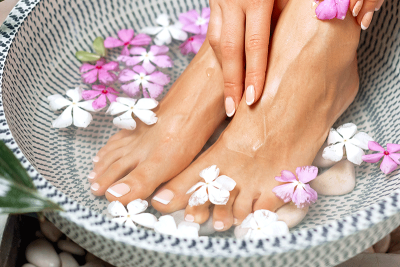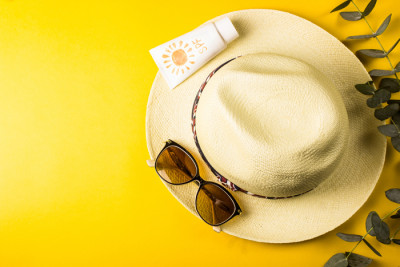12 summer skin problems you can prevent
How to prevent and treat common summer rashes
Summer means spending more time outdoors. However, the increased exposure to things like sunlight, insects, and poisonous plants can cause some itchy and painful rashes.
Fortunately, there a few simple steps people can take to avoid unwanted rashes, which can quickly sideline summer fun.
An itchy rash or sunburned skin can quickly sideline summer fun. You can help keep your days carefree and easygoing by learning how to prevent these summer skin problems.
Acne breakouts. When sweat mixes with bacteria and oils on your skin, it can clog your pores. If you have acne-prone skin, this often means breakouts. Dermatologists recommend the following to help prevent acne:
Dry, irritated skin. When outdoor air is hot and humid, you can still have dry irritated skin. The biggest culprits are spending time in the sun, pool, and air-conditioning. If your skin starts to feel dry and irritated despite the humidity, try these tips:
Folliculitis. Every hair on your body grows out of an opening called a follicle. When follicles get infected, you develop folliculitis. Infected hair follicles look like pimples, but they tend to be itchy and tender. To reduce your risk of getting folliculitis this summer:
Infection from a manicure or pedicure. Manicures and pedicures can leave your nails looking great, but they can also expose you to germs that can cause an infection.
You don’t have to give up manicures and pedicures. Taking some precautions can help you avoid an infection.
You’ll find out what dermatologists recommend at, Manicure and pedicure safety.Infection from a manicure or pedicure
Manicures and pedicures can leave your nails looking great, but they can also expose you to germs that can cause an infection. Find out what dermatologists recommend.

Melasma. Being out in the sun can make those brown to gray-brown patches on your face more noticeable.
There are things you can do to make it less noticeable even during the summer, Melasma: Tips for managing.Poison ivy, oak, and sumac (rash). Many people develop an intensely itchy rash when a substance found in these plants, urushiol, gets on their skin.
The best way to avoid this itchy rash is to learn what these plants look like and avoid them. You’ll find out how to identify these plants and protect your skin when you cannot avoid them at, Poison ivy, oak, and sumac.Poison ivy, oak, and sumac rash
Many people develop an intensely itchy rash when a substance found in these plants, urushiol, gets on their skin. The best way to avoid it is to learn what these plants look like.

Prickly heat (or heat rash). Blocked sweat glands cause this. Because the sweat cannot get out, it builds up under your skin, causing a rash and tiny, itchy bumps. When the bumps burst and release sweat, many people feel a prickly sensation on their skin.
Anything you can do to stop sweating profusely will help reduce your risk. Tips that dermatologists offer to their patients to help them sweat less and thereby lessen their risk of getting prickly heat include:Seabather’s eruption. Also called pica-pica, this itchy rash develops in people who go in the Caribbean Sea and the waters off the coasts of Florida and Long Island, New York. You get it when newly hatched jellyfish or sea anemones get trapped between your skin and your swimsuit, fins, or other gear.
The larvae are as small as a speck of pepper, so you won’t see them in the water. You can, however, prevent this rash if you:Sun allergy. You can develop hives (an allergic skin reaction) when you’re in the sun if you:
Sunburn. Getting sunburn can spoil summer fun and increase your risk of developing skin cancer. Here’s what you can do to prevent sunburned skin:
- Wear a wide-brimmed hat, sunglasses, long sleeves, and pants when possible
- Apply sunscreen that offers broad-spectrum protection, SPF 30+, and water resistance
Swimmer’s ear. When water gets trapped in your ear canal, you can develop an infection called swimmer’s ear.
You can prevent this infection by keeping your ears dry. Here’s what dermatologists recommend:Swimmer’s itch. Also called clam digger’s itch, this itchy rash appears after wading or swimming in lakes, oceans, and other bodies of water. You get it when parasites in the water burrow into your skin, causing tiny red spots on areas that your swimsuit didn’t cover. Sometimes, intensely itch welts (hives) and blisters appear.
Children are especially susceptible because they tend to stay in shallow, warmer water.
You can prevent swimmer’s itch by taking the following precautions:- Briskly rub your skin (and your child’s skin) with a towel after getting out of the water. The parasites start to burrow when the water on your skin begins evaporating not while you’re in the water.
You’ll find more ways to prevent breakouts at, Acne: Tips for managing
Prevent acne breakouts
Blot sweat from your skin with a clean towel or cloth. Wiping sweat off can irritate your skin, which can lead to a breakout.

Prevent dry, irritated skin
Shower and shampoo immediately after getting out of the pool, using fresh, clean water and a mild cleanser or body wash made for swimmers.

Seabather’s eruption
This itchy rash develops in people who go in the Caribbean Sea and the waters off the coasts of Florida and Long Island, New York.

Caution
If your skin stings with brisk rubbing, stop. You (or your child) may have seabather’s eruption.
To prevent an allergic skin reaction:
You’ll find more tips to protect your skin from the sun at, Prevent skin cancer.
Prevent sunburn
Seek shade, wear a wide-brimmed hat, sunglasses, long sleeves, and pants when possible.

Prevent swimmer's ear
You can prevent this infection by keeping your ears dry: Wear earplugs while swimming.

Stay out of infested waters to prevent swimmer's itch
When the water is infested, you may see a sign that tells you to stay out of the water, or you may hear about someone who recently developed an itchy rash after being in the water.

When to call a dermatologist
While these summer skin problems can dampen your fun, they’re usually not serious. Most go away in a few days to a few weeks. If a rash or other skin problem lingers or worsens, you should call your dermatologist’s office.
If you don’t have a dermatologist, you can find one at Find a dermatologist.
Images
Getty Images
References
Khachemoune A, Yalamanchili R, et al. “What is your diagnosis? Seabather’s eruption.” Cutis. 2006;77:148, 151-2.
McMichael A, Guzman Sanchez D, et al. “Folliculitis and the follicular occlusion tetrad.” In: Wolff K, Goldsmith LA, et al. In: Bolognia JL et al. Dermatology. (second edition). Mosby Elsevier, Spain, 2008: 517-9.
Wolff K et al. Fitzpatrick’s Dermatology in General Medicine (seventh edition). McGraw Hill Medical, New York, 2008:
Daly JS. Scharf MJ. “Bites and stings of terrestrial and aquatic life.” 2048-9.
Elston DM. “Sports dermatology.” 877.
Lim HW. “Abnormal responses to ultraviolet radiation: Photosensitivity induced by exogenous agents.” 828-32.
Mauro TM and Goldsmith LA. “Biology of eccrine, apocrine, and apoeccrine sweat glands.” 730.
 Atopic dermatitis: More FDA-approved treatments
Atopic dermatitis: More FDA-approved treatments
 Biosimilars: 14 FAQs
Biosimilars: 14 FAQs
 How to trim your nails
How to trim your nails
 Relieve uncontrollably itchy skin
Relieve uncontrollably itchy skin
 Fade dark spots
Fade dark spots
 Untreatable razor bumps or acne?
Untreatable razor bumps or acne?
 Tattoo removal
Tattoo removal
 Scar treatment
Scar treatment
 Free materials to help raise skin cancer awareness
Free materials to help raise skin cancer awareness
 Dermatologist-approved lesson plans, activities you can use
Dermatologist-approved lesson plans, activities you can use
 Find a Dermatologist
Find a Dermatologist
 What is a dermatologist?
What is a dermatologist?

